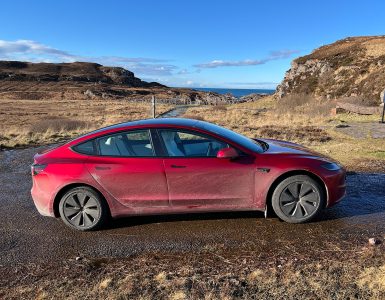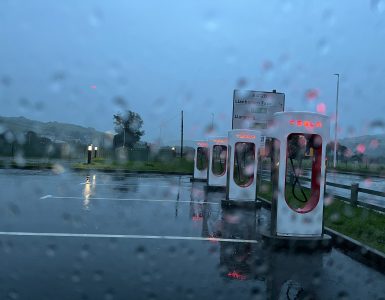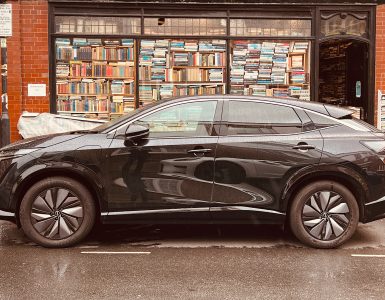EV day trips
There are some very common but really inaccurate misconceptions about driving electric cars that are still widely believed. One is that you can’t do high mileages or long trips in an electric car and that it takes hours to charge an EV.
So we’re doing some #EVDayTrips to bust some of these myths and show what electric cars trips are really like. These extremely long trips in the UK to show you can do it in an EV. Our first trip was 527 miles Putney to Padstow and back in a day.
The second was 475 miles Putney to Tenby return while the third took it up a notch…671 miles London to Scotland and back in a day! The 4th trip was 611 miles from London to Holyhead in Anglesey of which the first 523 miles was using public chargers only, avoiding Tesla Superchargers.
Including this trip to St Ives and Lands End the 5 EV day trips to date add up to 2,888 miles (4,658 km). To get an idea, that’s the same distance as driving from Oxford in England to Lisbon in Portugal.. and back again! The five return EV day trips averaged 577 miles each, a little further than a one way journey from London to Inverness.
So why choose these destinations apart from proving you can driving vast distances in an electric car? Well with the uncertainties of international travel since the pandemic and and now the awful actions of a crazy little man in Moscow, driving an EV that makes long trips relaxing and easy it really is the perfect time to explore beautiful parts of the UK that you haven’t had a chance to see before. For me it had been over a decade since I’d last been to Cornwall or the Lake District (which I drove through on the way back from Scotland), I’d never been to beautiful Tenby in south west Wales or Anglesey or on its northwest tip. All the destinations have had stunning scenery with dramatic coastlines and mountains to walk while there.
There really is no reason and no excuse to buy another premium brand oversized diesel SUV or saloon for £35,000 or more just because you do a trips to Cornwall, Wales, Scotland Norfolk, Gloucestershire etc. or do high mileage driving for work.
What’s an EV day trip like in winter though
Even driving a 2019 Tesla Model 3, the UK’s best selling electric car of 2021, (and the second best selling car overall ahead of cars like the Ford Focus and Fiesta) winter temperatures do affect range and efficiency. In most cases though it really shouldn’t affect your trips too much provided you can charge easily when you need to. You might just need an extra charge or a few minutes extra charging time but in a Tesla with fast Superchargers that’s pretty easy especially on or near motorways.
If journalists are to be believed public chargers are a hotchpotch of unreliable units that are impossible to use and as rare as hens teeth but if you choose your charging networks carefully it’s usually fine. We have a beginners guide to keeping your EV charging simple and chilled just here so that on a trip you can easily focus on fast chargers with multiple bays and contactless payment.
London to St Ives in Cornwall, then on to Lands end and back to London in a day
This trip was to see how winter temperatures affect a trip to Cornwall compared to last year’s first EV Day trip to Padstow in spring 2021. Having never been to St Ives this trip gave plenty of time to look round, visit the Tate Gallery there and grab a nice lunch. After that there was a further trip west as far as you can go on the UK mainland to Lands End before the return trip to London.
The trip

The overall trip stats
- I left London at 5.14 am with the battery around 70% charged
- This equated to 208 miles standard Tesla range which is based on 4 miles per kWh
- The temperature was a chilly 3C
- The round trip ended up being 599.0 miles and used 198 kWh of electricity
- charge time was 1 hour and 23 minutes excluding Lands End while out walking.
If I hadn’t plugged in at Lands End, but also charged just sufficiently to reach London total charge time would have been around 1 and a half hours for this winter return trip. - Efficiency was 331 Watt hours/ mile which is 3.02 miles per kWh
- Cost £72.93
- Around a 44% charge when I got home
Verdict
To be honest this was another fantastically easy journey. The early start meant no traffic around London so, remarkably, I was able to drive Amesbury, charge, grab a coffee and then pass Stonehenge all before the sun came up. It’s so easy I didn’t even bother fully charging before departure.
In fact the only surprise was how fantastically dirty the roads were. There had been no rain but the roads were mostly damp and oily. The car needed a thorough wash afterwards as even opening the boot needed a cloth to clean your hands after. Could it be that at low temperature diesel exhaust sticks to the road surface? Better there than in peoples lungs I suppose.
Charge stop 1 at 77.2 miles – Amesbury Supercharger

- Arrived with 70 miles range remaining
- Tesla range added – 186 miles in 26 mins
- Cost £16.80
- 32 KWh used to this point
Charge stop 2 at 207 miles – Lifton (Launceston) Tesla Supercharger
- Arrived with 55 miles range remaining
- Tesla range added 60 miles in 10 minute stop
- Cost £5.25
This was just a quick stop to ensure I had plenty of spare range to get to the new Camborne Superchargers for a proper charge
Charge stop 3 at Camborne Supercharger
- Arrived with 27 miles range remaining
- Tesla range added 106 miles in 10 mins so departed with 133 miles range
- Cost £11.52
Outbound trip summary
- 352 miles of Tesla range added
- Total charge time 46 mins
- Arrived in St Ives after 5hrs and 42mins including charging at 10:56am
- 245 miles from London at a cost so far of £33.57
Exploring St Ives and Lands End
In the end I had about 2 and half ours in St Ives exploring the town, visiting the Tate Gallery, grabbing an excellent lunch overlooking the harbour at the Porthminster kitchen. The promised sunshine didn’t emerge in St Ives at all, saving itself till I got to Lands End where it was very welcome
Lands End does have nice scenery but so does most of the Cornish coast. It’s basically more of a tourist trap than anything
Top Tips
- If you visit the Tate in St Ives DO visit the cafe after. I only noticed the roof terrace overlooking the beach after I left.
- Do take a bag of many pound coins to pay for parking at Lands End. It is a coin only machine – no cards or apps in Jan 2022! You’ll probably need at least 15 pound coins for a summer visit!
- Don’t count on the Gridserve charger at Lands End. There is a single slow 50kW unit (that worked) and a small AC charger next to it that didn’t. Between visitors and EV drivers starting a run to/from John O’Groats it’s not something you should expect to be available
- If you want to visit the Minack theatre check what days it is open. There is nothing to see of it when it is closed.
Return Charging stops
Charge stop 4 – Lands End
- Time – around 50 mins
- Cost £11.94
- Tesla range added – estimated 122 miles
Didn’t actually make a note of this as I really just plugged in because it was there during the visit to Lands End. I was there for about 50 minutes but was a good example of invisible charge time. I was there anyway so there was no “charge time”
Despite not being quick it got me enough charge to ignore the Superchargers at Camborne or Lifton and aim straight to the Exeter Supercharger 126 miles away for the return leg.
Charge stop 5 at 432 miles – Tesla Supercharger Exeter Darts Farm
- Arrived with 46 miles range remaining Tesla range
- added an estimated 27kWh or 108 miles in about 14 minutes
- Cost £9.57
Just needed enough charge to reach Amesbury for the final charge on the A303. Worth noting Exeter has both older Superchargers and some much faster V3’s at the back! (old chargers have 2 cables- V3s have 1
Charge stop 6 at 523 miles – Tesla Supercharger Amesbury
- Arrived with 33 miles range
- Added around 51kWH or an estimated 204 miles of Tesla range
- Charge time about 23 mins
- Charge cost £17.85
One of my favourite chargers and very fast. Added much more charge than needed to give me spare charge at home when I got back.
Return trip summary
- 37 mins charging excluding Lands End
- about 434 Tesla miles added or 312 excluding Lands End
Long Distance EV background information
Choosing an EV for longer trips – battery size and charging speed
People do long trips in all sorts of EV’s but 2 factors make it much much easier. An official range of between 200 and 350 miles helps a lot but the ability to charge to 80% in half an hour or less on DC rapid charging is crucial. To achieve this look for electric cars whose charging in kW at least double the size of their battery in kW/h.
A kilowatt-hour (kWh) is a measure of the amount of energy stored in your battery and the charging speed in kW is the amount that would be added in one hour. So if a car charged a 50kWh battery at a steady 50kW then 0-100% would take an hour while a slow AC charger at 10kW speed would take 5 hours. In reality charging speed slows from around 50% battery charge and becomes very slow beyond 80%. Luckily most owners will have at least 10% battery left when they start a charge and will unplug before 80% which keeps the times roughly in line.
When less well informed journalists or others refer to charging times in hours they are referring only to slow AC charging (or even 3 pin plugs!) that you would use for top ups or overnight charging at home usually at a maximum speed of 7kW to 11kW. Most EVs (except Renault Zoe’s that depend on 25kW AC) can switch to fast DC CCS charging when on a trip to charge at between a pedestrian 50kW and a super fast 350kW. It’s DC charging speed that matters if you want to charge in 30 mins or under on a trip.
The best way to charge EV’s on a long trip is usually more short charge stops of 15 to 25 mins rather than a long single charge stop. Charging from 10% to around 60% is much much faster than charging all the way to 100% and let you stretch your legs and have a tea and toilet stop.
















